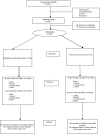Multifactorial assessment and targeted intervention to reduce falls among the oldest-old: a randomized controlled trial
- PMID: 24596458
- PMCID: PMC3940644
- DOI: 10.2147/CIA.S57580
Multifactorial assessment and targeted intervention to reduce falls among the oldest-old: a randomized controlled trial
Abstract
Background: The purpose of this study was to assess the effectiveness of a multifactorial intervention to reduce falls among the oldest-old people, including individuals with cognitive impairment or comorbidities.
Methods: A randomized, single-blind, parallel-group clinical trial was conducted from January 2009 to December 2010 in seven primary health care centers in Baix Llobregat (Barcelona). Of 696 referred people who were born in 1924, 328 were randomized to an intervention group or a control group. The intervention model used an algorithm and was multifaceted for both patients and their primary care providers. Primary outcomes were risk of falling and time until falls. Data analyses were by intention-to-treat.
Results: Sixty-five (39.6%) subjects in the intervention group and 48 (29.3%) in the control group fell during follow-up. The difference in the risk of falls was not significant (relative risk 1.28, 95% confidence interval [CI] 0.94-1.75). Cox regression models with time from randomization to the first fall were not significant. Cox models for recurrent falls showed that intervention had a negative effect (hazard ratio [HR] 1.46, 95% CI 1.03-2.09) and that functional impairment (HR 1.42, 95% CI 0.97-2.12), previous falls (HR 1.09, 95% CI 0.74-1.60), and cognitive impairment (HR 1.08, 95% CI 0.72-1.60) had no effect on the assessment.
Conclusion: This multifactorial intervention among octogenarians, including individuals with cognitive impairment or comorbidities, did not result in a reduction in falls. A history of previous falls, disability, and cognitive impairment had no effect on the program among the community-dwelling subjects in this study.
Trial registration: ClinicalTrials.gov NCT01141166.
Keywords: elderly; falls; intervention.
Figures
References
-
- Cameron ID, Murray GR, Gillespie LD, et al. Interventions for preventing falls in older people in nursing care facilities and hospitals. Cochrane Database Syst Rev. 2010;20:CD005465. - PubMed
-
- Formiga F, Ferrer A, Duaso E, Olmedo C, Pujol R. Falls in nonagenarians living in their own homes: the Nonasantfeliu study. J Nutr Health Aging. 2008;12:273–286. - PubMed
-
- Salvà A, Bolíbar I, Pera G, Arias C. Incidence and consequences of falls among elderly people living in the community. Med Clin (Barc) 2004;122:172–176. - PubMed
-
- Tinetti ME, Speechley M, Ginter SF. Risk factors for falls among elderly persons living in the community. N Engl J Med. 1988;319:1701–1707. - PubMed
Publication types
MeSH terms
Associated data
LinkOut - more resources
Full Text Sources
Other Literature Sources
Medical



